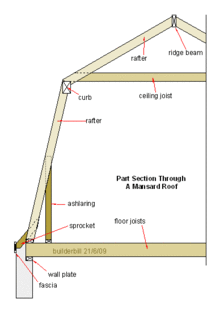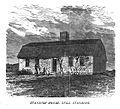Gambrel

The first Harvard Hall, Harvard University, credited to be the oldest known example of a gambrel roof in North America, built c. 1677, burned 1766.

A cross-sectional diagram of a mansard roof, which is a hipped gambrel roof
A gambrel or gambrel roof is a usually symmetrical two-sided roof with two slopes on each side. (The usual architectural term in eighteenth-century England and North America was "Dutch roof.") The upper slope is positioned at a shallow angle, while the lower slope is steep. This design provides the advantages of a sloped roof while maximizing headroom inside the building's upper level and shortening what would otherwise be a tall roof. The name comes from the Medieval Latin word gamba, meaning horse's hock or leg.[1][2] The term gambrel is of American origin,[3] the older, European name being a curb (kerb, kirb) roof. Europeans historically did not distinguish between a gambrel roof and a mansard roof but called both types a mansard. In the United States, various shapes of gambrel roofs are sometimes called Dutch gambrel or Dutch Colonial gambrel with bell-cast eaves, Swedish ~, German ~, English ~ , French ~, or New England gambrel.
The cross-section of a gambrel roof is similar to that of a mansard roof, but a gambrel has vertical gable ends instead of being hipped at the four corners of the building. A gambrel roof overhangs the façade, whereas a mansard normally does not.
Contents
1 Origin and use of the term
2 Origins of the gambrel in North America
3 Image gallery
4 References
5 Bibliography
Origin and use of the term
Gambrel is a Norman English word, sometimes spelled gambol such as in the 1774 Boston carpenters' price book (revised 1800). Other spellings include gamerel, gamrel, gambril, gameral, gambering, cambrel, cambering, chambrel[4] referring to a wooden bar used by butchers to hang the carcasses of slaughtered animals.[1] Butcher's gambrels, later made of metal, resembled the two-sloped appearance of a gambrel roof when in use.[5] Gambrel is also a term for the joint in the upper part of a horse's hind leg, the hock.
In 1858, Oliver Wendell Holmes, Sr. wrote:
.mw-parser-output .templatequoteoverflow:hidden;margin:1em 0;padding:0 40px.mw-parser-output .templatequote .templatequoteciteline-height:1.5em;text-align:left;padding-left:1.6em;margin-top:0
Know old Cambridge? Hope you do.—
Born there? Don't say so! I was, too.
(Born in a house with a gambrel-roof,—
Standing still, if you must have proof.—
"Gambrel?—Gambrel?"—Let me beg
You'll look at a horse's hinder leg,—
First great angle above the hoof,—
That's the gambrel; hence gambrel-roof.)[6]
An earlier reference from the Dictionary of Americanisms, published in 1848, defines gambrel as "A hipped roof of a house, so called from the resemblance to the hind leg of a horse which by farriers is termed the gambrel."[7] Websters Dictionary also confusingly used the term hip in the definition of this roof.
The term is also used for a single mansard roof in France and Germany. In Dutch the term 'two-sided mansard roof' is used for gambrel roofs.
Origins of the gambrel in North America
The origin of the gambrel roof form in North America is unknown.[8] The oldest known gambrel roof in America was on the second Harvard Hall at Harvard University built in 1677.[9] Possibly the oldest surviving house in the U.S. with a gambrel roof is the c. 1677–78 Peter Tufts House. The oldest surviving framed house in North America, the Fairbanks House, has an ell with a gambrel roof, but this roof was a later addition.
Claims to the origin of the gambrel roof form in North America include: 1) Spanish, Portuguese, Dutch, and English mariners and traders had visited or settled into the area of southeast Asia now called Indonesia prior to permanent European settlement in America. In Indonesia, they saw dwellings with a roof style where the end of a roof started as a hip and finished as a gable end at the ridge. The gable end was an opening, to allow smoke to dissipate from the cooking fires. This roof design was brought back to Europe and the American Colonies, and adapted to local conditions. The roof style is still in use around the world today;[10] 2) Seamen who traveled to the Netherlands brought the design back to North America;[11] 3) or practical reasons such as a way to allow wider buildings, the use of shorter rafters, or to avoid taxes.[12]
Image gallery
| Look up gambrel in Wiktionary, the free dictionary. |
| Wikimedia Commons has media related to Gambrels. |

Barn with a gambrel roof.

Print of original (1679–1752) Old Dutch Church (Kingston, New York) USA.
Dwelling with gambrel roof in Amityville, New York, made famous by The Amityville Horror.

If the date of construction and the roof of the Henry Bull House was original to the circa 1639 date this would be the oldest known example of a gambrel in America.

Another candidate for oldest gambrel roof, said to be from 1666, Alexander Standish House.
References
^ ab Harper, Douglas. "gambrel". Online Etymology Dictionary. Retrieved 2010-11-13..mw-parser-output cite.citationfont-style:inherit.mw-parser-output qquotes:"""""""'""'".mw-parser-output code.cs1-codecolor:inherit;background:inherit;border:inherit;padding:inherit.mw-parser-output .cs1-lock-free abackground:url("//upload.wikimedia.org/wikipedia/commons/thumb/6/65/Lock-green.svg/9px-Lock-green.svg.png")no-repeat;background-position:right .1em center.mw-parser-output .cs1-lock-limited a,.mw-parser-output .cs1-lock-registration abackground:url("//upload.wikimedia.org/wikipedia/commons/thumb/d/d6/Lock-gray-alt-2.svg/9px-Lock-gray-alt-2.svg.png")no-repeat;background-position:right .1em center.mw-parser-output .cs1-lock-subscription abackground:url("//upload.wikimedia.org/wikipedia/commons/thumb/a/aa/Lock-red-alt-2.svg/9px-Lock-red-alt-2.svg.png")no-repeat;background-position:right .1em center.mw-parser-output .cs1-subscription,.mw-parser-output .cs1-registrationcolor:#555.mw-parser-output .cs1-subscription span,.mw-parser-output .cs1-registration spanborder-bottom:1px dotted;cursor:help.mw-parser-output .cs1-hidden-errordisplay:none;font-size:100%.mw-parser-output .cs1-visible-errorfont-size:100%.mw-parser-output .cs1-subscription,.mw-parser-output .cs1-registration,.mw-parser-output .cs1-formatfont-size:95%.mw-parser-output .cs1-kern-left,.mw-parser-output .cs1-kern-wl-leftpadding-left:0.2em.mw-parser-output .cs1-kern-right,.mw-parser-output .cs1-kern-wl-rightpadding-right:0.2em
^ Harper, Douglas. "gambol". Online Etymology Dictionary. Retrieved 2010-11-13.
^ Oxford English Dictionary, 2nd ed., Gambrel:4.
^ A New English Dictionary on Historical Principles: Founded Mainly ..., Volume 4. p. 36.
^ US patent 1345112, W. A. Andrew, "Release gambrel", issued 1920-06-29
^ Homes, Oliver Wendell Sr. (October 1858). " The Professor Under Chloroform". The Atlantic Monthly. 2:No. 5. Washington D.C.: Jay Lauf. Wikisource.
The Professor Under Chloroform". The Atlantic Monthly. 2:No. 5. Washington D.C.: Jay Lauf. Wikisource.
^ Bartlett, John Russell (1848). "GAMBREL". Dictionary of Americanisms: a glossary of words and phrases, usually regarded as peculiar to the United States. American culture. New York: Bartlett and Welford. p. 153. OCLC 6758564.
^ Kelly, John Frederick. Early domestic architecture of connecticut. Unknown: 1924, Dover Publications, Inc. reprint 1963. 63.
^ Harris, Cyril M.. American architecture: an illustrated encyclopedia. New York: W.W. Norton, 1998. 144.
ISBN 0393731030
^ Allen, James H. (2010). Statics for Dummies. For Dummies. Hoboken, New Jersey: Wiley. p. 255. ISBN 978-0-470-59894-8. OCLC 505422830.
^ "Atwood House Restoration Project Documentary Video". Atwood House Museum. Retrieved 5 August 2013.
^ Robert E. Lee Memorial Foundation. Stratford: Colonial Home and Plantation, Westmoreland county, Virginia: birthplace of Robert E. Lee and of two signers of the Declaration of Independence. Press of B. S. Adams, 1940. 27.
Bibliography
Corkhill, Thomas (1982). "Gambrel roof". The Complete Dictionary of Wood. Scarborough Books (1st ed.). New York: Stein and Day. p. 211. ISBN 0-8128-6142-6. OCLC 12610712.






